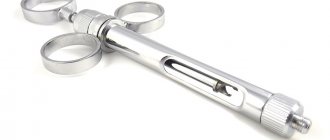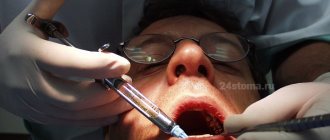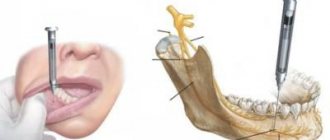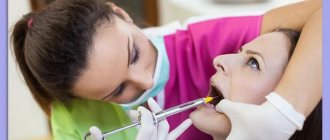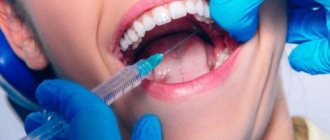What is Articaine and what is its composition?
Articaine is an amide anesthetic intended for local, infiltrative or conductive anesthesia for both simple and complex dental procedures. A local anesthetic blocks the generation and conduction of nerve impulses, presumably by increasing the threshold of electrical excitation in the nerve, slowing the propagation of the nerve impulse, and decreasing the rate of rise of the action potential.
The uniqueness of Articaine as a member of the amide family is that it contains an ester group and a thiophene instead of a benzene ring. The thiophene ring increases the lipid solubility of articaine, facilitating more efficient diffusion of the anesthetic across the lipid membrane of nerve cells into surrounding tissues. Articaine is widely used in dentistry due to its safety during short procedures that require rapid onset of anesthesia.
The onset of action of the drug Articaine is:
- from 1.5 to 1.8 min. with infiltration of the upper jaw;
- from 1.5 to 3.6 min. with block anesthesia of the lower jaw.
Articaine pulp anesthesia lasts from 30 to 120 minutes. Anesthesia of soft tissues with the drug lasts ~ 2.25 hours for infiltration of the upper jaw, 4 hours for blockade of the lower jaw.
The drug is produced in the form of an injection solution - a transparent, colorless or yellowish liquid. For retail sale to pharmacy chains, Articaine is supplied in ampoules made of colorless chemically pure glass, enclosed in blister packs and/or cardboard packs.
Composition of articaine in dentistry:
- active agent - articaine hydrochloride;
- Excipients: sodium chloride (to make the solution isotonic) and distilled water.
1 ml of solution contains 40 mg of active agent.
In odonto-dental anesthesia, articaine is used alone or in combination with epinephrine (adrenaline). Epinephrine, diluted to 1:100,000 or 1:200,000 and added to the solution, slows down the passage of articaine into the general bloodstream and thus ensures long-term maintenance of the concentration of the active substance in the tissues, allowing a small hemorrhagic surgical field to be obtained.
It is possible to replace Articaine with synonyms with the same active substance, such as:
- Artikain-Binergy;
- Ultracaine;
- Artikain-DF;
- Articaine with Epinephrine.
The decision to use analogues is made by the attending physician, taking into account the individual characteristics of the patient.
The choice of anesthetic in dental treatment
The middle and older generations of our country remember very well the times when the need to seek help from a dentist for the prevention and treatment of teeth was associated with the unpleasant feeling of severe and difficult-to-bear pain awaiting the future patient, and therefore a visit to the doctor was made only in cases of the most extreme and urgent need. Modern dentistry, unlike the level of dentistry of the 80-90s of the last century, is much better armed. The most popular anesthetic in dentistry of the past, novocaine, is irretrievably becoming a thing of the past and has been replaced by new drugs that are less toxic and more effective.
When choosing an anesthetic, important indicators are:
- effectiveness of pain relief
- good tissue permeability and long-lasting analgesic effect of the drug
- minimal toxicity and safety of the drug
Since almost all modern drugs are quite effective, the most important point when choosing an anesthetic is its safety.
No less important when choosing an anesthetic is its relationship to the vasoconstrictor (a drug that narrows blood vessels, which leads to a decrease in blood flow in them and prolongs the effect of the drug) - adrenaline. For many patients with pathologies of the cardiovascular system, with endocrine pathologies, patients with bronchial asthma and other diseases, vasoconstrictor-adrenaline is contraindicated. In addition, adrenaline itself maintains a high level of stress, which is undesirable during treatment.
The most popular and corresponding to the above requirements are the following anesthetics:
- Ultracaine DS forte
- Ultracain DS
- Scandonest SVC
Ultracaine DS forte and Ultracaine DS The main anesthetic substance for these drugs is Articaine, which is 2 times more effective than lidocaine and 6 times more effective than novocaine. The drug is completely excreted from the body and is non-toxic, since it does not contain parabens (anesthetic preservatives), there is practically no allergic reaction to the substance and, according to clinical studies, the drug is safe in 99.4% of cases. The main advantages of the drug are:
- high efficiency of the drug with a low degree of toxicity
- almost instantaneous effect of the drug (from 30 seconds)
- safety of the drug for pregnant and nursing mothers, as well as for preschool children
- The duration of anesthesia depends on the anesthesia technique used by the doctor (from 1.5-2 hours when treating one tooth and up to 5-6 hours for more complex dental treatment methods).
Teeth to which standard therapy is applicable are best anesthetized with Ultracaine DS with a minimal content of adrenaline. The effectiveness of the drug is quite sufficient for a fairly long operation, and only in difficult cases is it recommended to use Ultracain DS Forte with a higher concentration of the vasoconstrictor.
Scandonest SVC This drug is recommended for patients for whom the vasoconstrictor-adrenaline is strictly contraindicated (patients with pathologies of the cardiovascular system, etc.) since it itself has a vasoconstrictor effect and therefore can be used without adrenaline.
Manufacturers Articaine
On the Russian pharmaceutical market, the anesthetic Articaine and its analogues are represented by domestic and foreign manufacturers. You can buy articaine in St. Petersburg and Moscow using the link.
The products of the following enterprises are most in demand:
- JSC "Biokhimik" (Russia);
- CJSC "Binergy" (Russia);
- LABORATORY INIBSA, SA (Spain);
- Welfarm LLC (Russia);
- Armavir biofactory FKP (Russia);
- Borisov Medical Preparations Plant (Republic of Belarus);
- Sanofi-Aventis Deutschland GmbH (Germany).
Preparations based on articaine, created at different enterprises, may have certain differences due to production technology, quantitative and qualitative composition of excipients, but at the same time retain the main direction of action of the active substance.
Articaine: side effects
Such qualities of Artican as low fat solubility, high% binding to blood proteins, low half-life ensure low toxicity of the drug. However, depending on the general condition, age, individual reactions of the patient and his existing systemic diseases, side effects may be observed during anesthesia with the drug, such as:
- disturbance or confusion;
- vertigo;
- headache;
- nausea;
- dyspnea;
- decreased blood pressure;
- diplopia;
- muscle tremors;
- allergic and local reactions, manifested in symptoms of urticaria, conjunctivitis, rhinitis, skin hyperemia, swelling and inflammation at the injection site.
Articaine should be used with caution during dental procedures in patients with impaired cardiovascular function, vascular diseases, liver and kidney failure.
Anesthesia with adrenaline. Why is it used in dentistry?
Anesthesia with adrenaline. Why is it used in dentistry?
Modern dentistry involves pain-free dental treatment. To do this, local anesthesia is used - an injection into the gum next to the tooth in order to temporarily “turn off” the transmission of nerve impulses from the tooth to the brain along the nerve fibers. For this, local anesthetics are used - and if previously it was novocaine or lidocaine, now preference is given to the latest generation drugs - articaine and mepivacaine (they are safer, have fewer side effects, and the risk of developing an allergy to these drugs is much lower).
The anesthetic is injected into the soft tissue of the gums, where a “depot” is created from a substance that works for a certain time. From this “depot” the drug gradually seeps into the blood vessels and is washed out with the bloodstream. In order for this resorption of the anesthetic to proceed more slowly and the anesthesia to work longer, the anesthesia drug contains not only the active substance itself, but also a very small amount of adrenaline - adrenaline has a powerful vasoconstrictor effect, it causes a narrowing of the lumen of the capillaries in the gum, thereby slowing down resorption of the injected anesthetic and increases the duration of anesthesia.
In addition, due to the constriction of blood vessels in the anesthesia zone, provided by adrenaline,
the bleeding of the tissues surrounding the tooth is reduced
, which is especially important during surgical procedures, for example, during tooth extraction.
Different anesthetic drugs contain different amounts of adrenaline (epinephrine). The choice of drug depends on the dental procedure being performed, the age of the patient and the presence of chronic diseases. So, for example, if you plan to treat minor caries, then choose a drug with a low adrenaline content. If it is necessary to remove a tooth or install an implant, then an anesthetic is used, which contains more adrenaline.
A side effect of adrenaline can be increased blood pressure and increased heart rate. In elderly patients, people with diseases of the cardiovascular system, children and other groups of patients, if there are contraindications, anesthesia with minimal or no adrenaline can be used. In this case, the choice is a drug with the anesthetic mepivacaine, and not with articaine, because Mepivacaine itself has a slight vasoconstrictor effect.
Therefore, before starting any dental procedure, in order to choose the right drug, it is so important to inform the doctor about all existing diseases and conditions, about your health and reactions to anesthesia in the past.
Articaine during pregnancy in dentistry
Articaine is usually well tolerated at all stages of pregnancy. There is no data on the long-term effects of the drug on the neurophysiology of the newborn. Also, no teratogenic damage was observed after use of the drug in the first trimester.
There are no data from clinical studies of the penetration of Articaine into breast milk. To minimize possible risk to the baby, breastfeeding mothers may choose to express milk for approximately 4 hours after the injection. After which breastfeeding can be resumed.
Artikain
Articaine is a local anesthetic. It acts by stabilizing neuronal membranes, preventing the generation and propagation of a nerve impulse. It is used for infiltration (when the area of branching of nerve endings is anesthetized) and conduction (when a large nerve trunk is blocked) anesthesia during surgical interventions and diagnostic procedures. Widely used in dentistry. As you know, most dental procedures are accompanied by pain of varying degrees, and only adequate anesthesia can prevent the patient from developing a full-fledged phobia about visiting the dentist. Currently, the most effective and safe method of pain control in dentistry is local anesthesia, which is used in 98% of interventions. Articaine was synthesized in the late 1970s. To this day, it remains one of the most effective local anesthetics. One of its key advantages is its relatively short (about 30 minutes) half-life and a large proportion of binding to plasma proteins (up to 95%), i.e. with accidental intravascular administration, the likelihood of causing a toxic effect is minimal. In addition to this, the drug diffuses to the maximum extent into bone and soft tissue, which means it is fast (within 1-11 minutes) and sufficient in duration (60-225 minutes).
) analgesic effect. The dose is determined individually based on the indications and dosage form used. After intramuscular administration, the peak concentration of the active component is recorded in the blood after 20-40 minutes. When passing through the liver it is completely metabolized. It is quickly removed from tissues. Elimination from the body occurs mainly through urine. In case of a lack of the enzyme pseudocholinesterase, neurocirculatory dystonia, lesions of the central nervous system of various origins, pernicious anemia, conditions of chronic oxygen starvation, articaine is used with extreme caution. It is allowed to combine the drug with adrenaline and glucose. Tricyclic antidepressants (amitriptyline, imipramine, clomipramine, desipramine, etc.) potentiate the antihypertensive effect of articaine. When using the drug in gynecological practice, especially when blocking the paracervical nerve, a decrease in the heart rate of the fetus is possible. Articaine passes into breast milk only in small quantities, so anesthesia using this drug is also possible during breastfeeding. When using articaine, the following side effects may develop: headaches, visual disturbances, shortness of breath, apnea, involuntary trembling of the fingers, convulsions, dyspeptic disorders, decreased blood pressure, allergic manifestations.
Instructions for use
To exclude or minimize intravascular administration of Articaine, an aspiration test is required before using the drug. An accurate and slow technique for injecting the drug is required with control of the pressure on the syringe plunger depending on the sensitization of the tissue.
The instructions for use in dentistry recommend using Articaine in a dosage corresponding to the nature of the manipulation:
- 1.7 ml of solution per tooth for uncomplicated extraction of the upper jaw tooth;
- 0.1 ml for anesthetizing incisions when creating a palatal depot and suturing;
- 0.5-1.7 ml per tooth for grinding teeth for crowns and in case of cavity preparation.
After each injection of Articaine, careful and constant monitoring of vital signs of the cardiovascular and respiratory systems (adequacy of ventilation) and the patient’s state of consciousness should be carried out.
using Articaine in dentistry for infiltration anesthesia during extirpation of mandibular premolars.
Articaine in pediatric dentistry
The pharmacodynamics of local anesthetics in children is comparable to that in adults. In pediatric dental practice, extreme caution must be exercised when using amide local anesthetics as lower intrinsic clearance or decreased serum protein binding may easily lead to an increased risk of toxic reactions. The route of administration is one of the main safety factors when using local anesthetics in neonates and children.
Anesthesia in dentistry with the drug Articaine , carried out using intraosseous injection, is effective in achieving deep anesthesia of teeth affected by MIG with hypersensitivity associated with chronic inflammation of the pulp in children.
In pediatric dentistry, it is recommended to use Articaine 2% due to the lower Cmax and shorter half-life of the drug.
Anesthesia in dentistry
The best drugs for local anesthesia in dentistry
As we said, most often in dental clinics drugs based on articaine are used, in particular Ultracaine or Ubistezin. Now, taking into account the information presented, it is time to dwell in more detail on the advantages of such anesthetics.
Artikain
Modern local anesthesia in dentistry is unthinkable without articaine. It is this anesthetic that has a minimal ratio of toxicity and analgesic activity. In other words, among the most effective remedies, it is the least toxic.
Articaine is actively used for infiltration and conduction anesthesia. It is also used for intraosseous anesthesia before dental operations. But the surface anesthetic effect of articaine is not typical, which is why it is not suitable for applications.
The advantage of articaine is its high effectiveness against inflammation. (The inflammatory process reduces the effect of many drugs). This feature allows the use of Ultracain or Ubistezin in the treatment of purulent-inflammatory diseases of teeth and periodontium.
Due to its low toxicity, articaine is the best remedy for pediatric dentistry, the elderly, and patients with diseases of the hepatobiliary and urinary systems. Can be used while breastfeeding. Articaine practically does not penetrate into breast milk, and if it is found in it, it is in extremely low concentrations that have no clinical significance.
Can articaine be used during pregnancy? Studies have shown that although articaine crosses the placental barrier, it does not have a toxic or mutagenic effect on the fetus. Articaine can be used during pregnancy.
Lack of articaine in the average duration of action. It is quickly absorbed into the blood, quickly destroyed and excreted in the urine. This is partly due to the fact that articaine, like many local anesthetics, dilates blood vessels. For this reason, articaine is often used together with vasoconstrictors, which are already included in the drug. For example:
- Ultracain DS Forte, Ubistezin Forte contain adrenaline in a concentration of 1:100,000 (average concentration).
- Ultracain DS, Ubistezin contain adrenaline in a concentration of 1:200,000 (low concentration).
What if the patient belongs to a risk group and cannot be injected with an anesthetic with adrenaline? In this case, you need to use Ultracaine D - a drug with articaine without a vasoconstrictor component.
During pregnancy, it is recommended to use articaine in combination with adrenaline in low concentrations (Ubistezin, Ultracaine DS). Some experts believe that it is better not to use vasoconstrictors at all when treating pregnant women. Which option is better? The choice must be made taking into account individual characteristics. A woman should consult with specialists, including a gynecologist who monitors the pregnancy.
Lidocaine
Lidocaine is another popular and widely used drug, despite the fact that it is 2 times more toxic than procaine. The advantage of lidocaine is its average duration of action and more pronounced effect (it is 4 times stronger than procaine). The problem is that lidocaine dilates blood vessels, which requires the simultaneous use of high doses of a vasoconstrictor drug. For this reason, lidocaine is rarely used for conduction or infiltration, but is often used for superficial anesthesia.
Can lidocaine be used during pregnancy? We have already mentioned one drawback - the drug requires the use of adrenaline in high concentrations. The second disadvantage of lidocaine is that it is toxic, crosses the placenta and accumulates in the fetal liver. Considering the above, local anesthesia with lidocaine is contraindicated for pregnant women.
Mepivacaine
A unique drug, because it is the only anesthetic for local anesthesia with a vasoconstrictor effect. This feature allows the use of mepivacaine without a vasoconstrictor, which makes it the best tool for providing anesthetic benefits to patients at risk (diabetes, thyroid disease, hypertension and other cardiovascular diseases).
Mepivacaine is actively used for infiltration and conduction anesthesia. It is contraindicated during pregnancy because it penetrates the placental barrier and narrows the uterine arteries, which can lead to fetal hypoxia.
Anesthesia in pediatric dentistry
The problem of anesthesia in pediatric dentistry is quite acute, since it is psychologically and physically difficult for young patients to withstand a long treatment procedure. On the one hand, they are frightened by the noise of dental instruments, on the other hand, it is simply difficult for them to sit still for 40-60 minutes. In this regard, instead of local anesthesia, the dentist may recommend anesthesia.
Anesthesia in pediatric dentistry is carried out using a modern drug - Sevoran. Unlike the previously popular ZAX (nitrous oxide-oxygen mixture), Sevoran combines not only high efficiency (sufficient depth and duration of medicated sleep), but also maximum safety and a very “clean” recovery from anesthesia. After waking up, the child feels great; headaches, nausea or dizziness are extremely rare.
You can learn more about the methods of providing anesthesia in pediatric and adult dentistry at a consultation with a medical dentist.
Make an appointment
Reviews from dentists about the drug Articaine
Most practicing dentists consider Articaine to be the best representative of local anesthetics due to its high effectiveness. At the same time, when using the medication, there is a low incidence of allergic reactions, the possibility of safe use in pregnant women, and the absence of addiction. The only small drawback of Articaine, according to experts, is the inability to prescribe it to children under 4 years of age. In all other cases, Articaine is rightly called one of the drugs of choice.
This information is intended for medical professionals and specialists.



